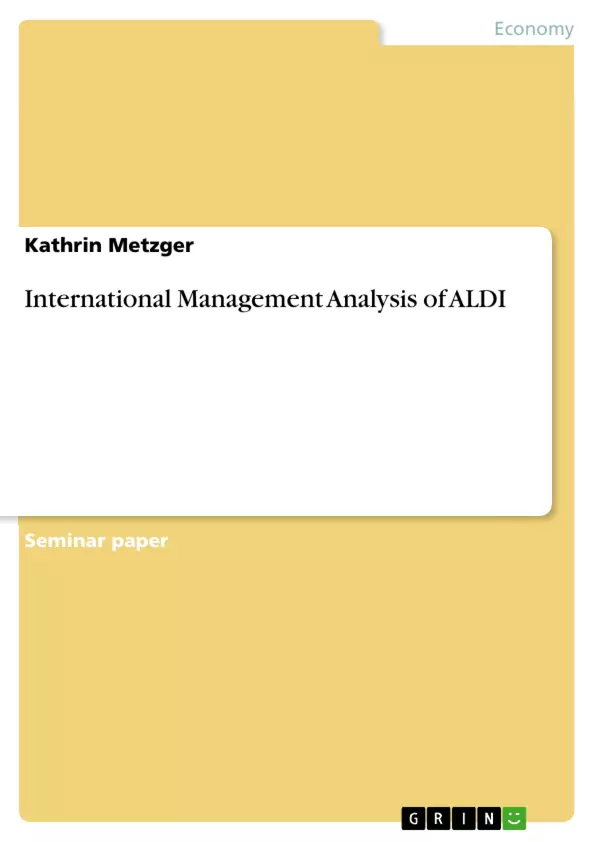This analysis intends to look into how Aldi started out in Germany and how the company expanded not only within Germany, but also its worldwide expansion specifically that of Aldi Süd and its entry into the UK and Australian markets. It will start by giving an overview of Aldi as a company, how it operates and its history. The analysis will be conducted with the help of the Bartlett and Ghoshal Framework that will be introduced in the literature review, but also through ascertaining how culture theories by Hofstede, Trompenaar and Lewis apply.
The objective of this analysis is to identify how Aldi Süd overcame the challenges that come with expanding and operating on an international basis and identify whether the company is international, global, multinational or transnational according to Bartlett and Ghoshal. In this context the cultural theories will also be used to assess the cultural issues Aldi was confronted with by expanding internationally more specifically when entering the UK and Australia and how Aldi dealt with these issues.
Table of Contents
- Introduction
- Research Objectives
- Company Overview
- Literature Review
- Bartlett and Ghoshal's Transnational Typology
- Competitive Challenge
- Collaborative Challenge
- Organisational Challenge
- Worldwide Learning Challenge
- Managerial Challenge
- Criticism of Bartlett and Ghoshal
- Cultural Challenge (Hofstede, Trompenaar and Lewis)
- Hofstede
- Trompenaar
- Lewis
- Criticism of Cultural Dimensions
- Company Analysis
- Development and Expansion of Aldi in Germany, UK and Australia
- Related and Supporting Industries in Germany, UK and Australia
- Firm Strategy and Structure
- Competitive Challenge
- Organisational Challenge
- Worldwide Learning and Innovation Challenge
- Cultural Challenge
- Conclusion
Objectives and Key Themes
This analysis aims to examine Aldi Süd's international expansion, particularly its entry into the UK and Australian markets. It explores how the company navigated the challenges of operating on an international scale and identifies its internationalization strategy based on the framework by Bartlett and Ghoshal. Furthermore, the analysis investigates the influence of cultural factors, drawing upon theories by Hofstede, Trompenaar, and Lewis, and assessing how Aldi adapted to these cultural dimensions.
- Aldi Süd's international expansion strategy
- Application of Bartlett and Ghoshal's Transnational Typology to Aldi Süd's operations
- Impact of cultural differences on Aldi Süd's internationalization
- Analysis of cultural dimensions according to Hofstede, Trompenaar, and Lewis
- Aldi Süd's approach to managing cultural challenges
Chapter Summaries
The first chapter introduces the research objectives, focusing on identifying the challenges Aldi Süd faced during its international expansion and determining its internationalization strategy according to Bartlett and Ghoshal's framework. It also presents an overview of the company's history, operations, and its global presence.
The second chapter delves into the relevant literature, introducing Bartlett and Ghoshal's Transnational Typology and its four main challenges: competitive, collaborative, organizational, and worldwide learning challenges. It also explores various cultural theories by Hofstede, Trompenaar, and Lewis, analyzing their frameworks and criticisms.
The third chapter provides a detailed analysis of Aldi Süd, examining its development and expansion in Germany, the UK, and Australia. It analyzes the company's competitive challenges, organizational structure, global learning and innovation, and its approach to managing cultural differences in each market.
Keywords
This analysis focuses on international management, global expansion, discount supermarkets, Aldi Süd, Bartlett and Ghoshal's Transnational Typology, cultural dimensions, Hofstede, Trompenaar, and Lewis, internationalization strategy, competitive advantage, organizational structure, global learning and innovation, cultural adaptation, and international market entry.
- Arbeit zitieren
- Kathrin Metzger (Autor:in), 2014, International Management Analysis of ALDI, München, GRIN Verlag, https://www.grin.com/document/283543



